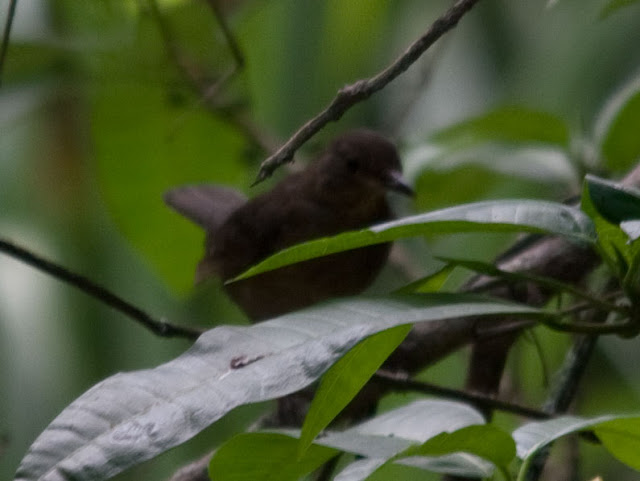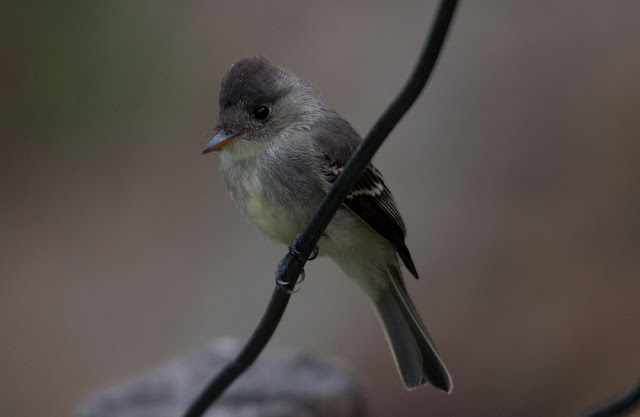 |
| The main reservoir |
This will be the first in a few short notes I will write up
on where to find birds around Lambayeque. The amount of information that exists
in the public domain seems to be small and thus most people visit (with a
guide) Bosque de Pomac, Chapparri and perhaps, Puerto Eten. However, there are
many other easily-accessible and productive sites in the region where you can
see birds not found in any of the other locations.
 |
| Comb Duck, one of the "specialties" here. |
The represa (dam) at La Viña is the first and most
productive spot to spend a few hours in the area during the wet season of
Dec/Jan – May/June. Birds you can usually see here include: Comb Duck, Least
Grebe, Cocoi Heron, Purple Gallinule, Brown-chested Martin and with a little
bit of luck you can find Masked Duck, Stilt Sandpiper, Collared Plover and
more. It is clearly the best location in Lambayeque, if not all of the
northwest coast to see Comb Duck and Least Grebe – other records are scattered
widely, but this spot produced the former on almost every visit and the latter
on every visit.
 |
| Least Grebes, juveniles, I believe |
To get to the site, the easiest thing to do is to charter a
car or a mototaxi in the town of Jayanca – ask for “la represa” – everyone
knows it. We generally pay ~20 soles for a station wagon to go to the dam or ~8
soles for a mototaxi. Note that there are two roads that abut the reservoir,
the first beginning on the Panamericana near one of the Jayanca public schools,
just past the town and the other winding through the oddly run-down town of La
Viña. Either is fine, but the birding is better on the north side, which is the
side accessible through La Viña. I have never felt really unsafe here and there
are usually a few other people around fishing or swimming, which is better than
a desolate location, in my opinion. Before the driver leaves, you ought to make
arrangements for the taxi/moto to return and get you.
 |
| General map - on google earth there is no water present, so I had to draw it in. The brown lines are the trails. |
When you arrive at the represa (the actual dam) you have
three options of paths, as seen in the rough map. If you have enough time (3-4
hours), walking the entire loop around the big reservoir is the most productive
route and you can expect to see 50-70 species. If you have less time, you can
still see 40+ species in an hour or so just by walking the first half of the
middle path and the path on the west side where you can see the small adjacent
ponds. My walkthrough will take you through assuming you are walking the whole
loop and the water level is high.
 |
| Raucous Cattle Egret nests are the first thing you will see. |
Begin by scanning the shoreline underneath the mesquite
trees on your left. This spot usually has a few Black-necked Stilts and until
April holds lots of sandpipers, though usually fairly spread out. Walk slowly
along the trail, carefully minding the shoreline of the smaller lagoon to your
left for sandpipers and ducks, which are often hidden until they flush. On your
right, scanning the water usually produces Great Grebes and Neotropical
Cormorants, but occasionally there will be a raft of Comb Duck or mixed Anas
species. Several herons, including Cocoi and Striated, perch on trees on the
island, so keep your eyes open for them, too.
 |
| Striated Heron |
Cattle egrets nested in huge numbers in mesquite trees on
the left along the first 400 meters or so of the trail this year, but apparently
this is not a yearly occurence. Also in these trees we encountered
Brown-chested Martins nesting in an old Pale-legged Hornero nest as well as roosting
Black-crowned Night-herons and Little Blue Herons. Continue walking and
scanning the shoreline to your left, while keeping your eye open for birds
flying over – this is the most common way of seeing Comb Ducks. After about ¾
of this trail, the left side starts to open up a bit. These trees are the best
spot to find roosting herons of all types: Yellow- and Black-crowned Night,
Cocoi, Striated, Little Blue and all the egrets. As you come to the end of the
trail, turn right along the top of the dike, don’t go down to the road below.
 |
| Horrible picture, but adult Yellow-crowned Night Heron, May-2 |
This trail is generally the slowest birding, but in the
visible crop fields you can find all the common species of the Chacras:
Chestnut-throated, Variable and Parrot-billed Seedeaters, Blue-black Grassquits,
Peruvian Meadowlarks and Burrowing Owls. At a certain point, you will start to
see wetlands on your left. Stop at each little pool for 5-10 minutes and look
for movement and listen. The more overgrown pools hold Purple and Common
Gallinule and Plumbeous Rail, while the more open ones hold lots of Least Grebe
(listen for their strange call note) and if you are lucky, Masked Duck as well.
Striated Herons hunt from along the banks, so watch for them.
 |
| Purple Gallinule, you can often see them with young following |
The two ponds that seem to hold Masked Duck are the last one
on the left (just past the irrigation channel) and the shallow wetland across
the road, as visible from the dike halfway between the represa and the last
pool. I would not be surprised if it were in more (all) of the ponds, they are
just devilishly small and furtive and you need a little bit of luck and a bit
of patience to see them here.
 |
| Adult Male Masked Duck |
In the corner by these two pools, large groups of swallows
often gather to drink. I have seen Brown-chested, Gray-breasted and Purple
Martin as well as Chestnut-collared, Barn, Bank, Blue-and-white and Southern
Roughwing Swallows. I can imagine just about any wayward swallow honing in on
this area, so perhaps others are possible (Cliff, White-winged, Peruvian
Martin?).
 |
| I suspect these are all juveniles and that local breeding occurred. |
This walk-through is in no way complete, but gives you a
pretty good start of how to approach the visit. On the timing note, I think
that like most places, the very early morning and the late afternoon are the
best. The late afternoon is especially striking as the herons return to roost
by the hundreds, a constant river of birds overheard.
 |
| The view from the dam, Cattle Egret nests in background. |
I would love to hear all feedback and all trip
reports/lists. I sort of consider this site my baby, so I would be curious to
hear what others think. Both Jimmy Tarrant and Fernando Angulo were very high
on the site when I brought them to see it… hopefully it continues to impress.
 |
| The crew of Jimmy, Orla, Juan and Sol wait for Masked Duck, this day without success. |
A short list of birds I expect to be found here by diligent
observers, keep your eyes and ears out and let me know if you do find these or
other new birds for the site:
Spotted Rail – Fernando Angulo expects it and the small
ponds with vegetation are perfect for it.
Sora/Virginia Rail – they occasionally migrate further south
and in the right season in stopover for a day or two, I can see them being
found here.
Tricolored Heron – I have found this species on the Motupe
River, but it ought to be here as well.
Osprey – there are plenty of fish here and in Feb/March they
are commonly seen flying over Pomac.
Black-faced Ibis – this severely declining population is
being hunted and developed out of existence, but I would imagine that the few
remaining do stop by here on a regular basis.
Peruvian Booby – wildcard. It has been found on Tinajones
and we found it flying over Pomac, no more than 10km from here. One ought to
turn up eventually, probably tailing stiff winds.
Common Pootoo – should be around in the adjacent forest, as
it is in Pomac near the river.
Peregrine Falcon – Juan Molina and I saw one on the adjacent
hills, but it would be a spectacular spot for a Peregrine to pick off shorebirds
or ducks.
Least Bittern – should be in the reedy areas, though I have
not heard it calling. Perhaps a bird to try playback for.
This (bad) video gives you a little overview of the site including the herons coming in to roost. Taken with a bad point and shoot, so don't expect much.





















